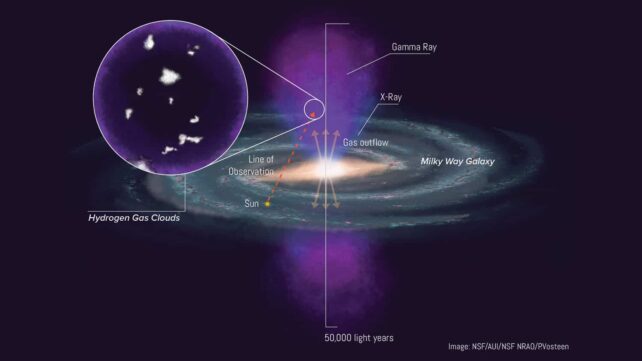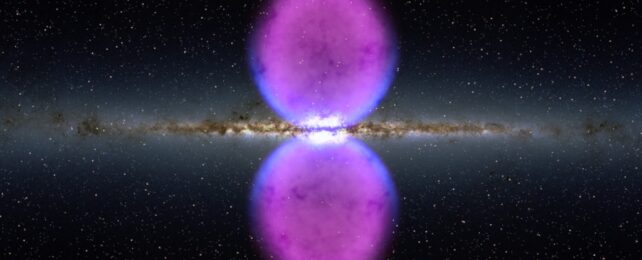Astronomers have found 11 unexpectedly cold hydrogen clouds hiding in the superheated turbulence of the Fermi Bubbles, in a discovery likened to finding ice cubes inside a volcano.
The Fermi Bubbles are two lobes of incredibly energetic gas that extend 25,000 light-years above and below the Milky Way's disk, spanning a total height of 50,000 light-years.
These still-mysterious structures were revealed in 2010 by the Fermi Gamma-Ray Space Telescope, which gave them their name. They originated from an outburst of galactic proportions, likely from the Milky Way's central black hole, and are moving at millions of miles per hour.
Related: Giant Bubbles Expanding From The Milky Way Could Be Explained by a Single Event
Now, using the unique capabilities of the US National Science Foundation Green Bank Telescope (NSF GBT), astronomers performed the deepest-ever radio survey of the Fermi Bubbles, twice as sensitive as previous surveys, and discovered 11 relatively cool, neutral hydrogen clouds embedded within these extreme environs.
The Milky Way harbors many violent environments and the Fermi Bubbles are among the most intense. The plasma here reaches a temperature around 1 million Kelvin (999,730 degrees Celsius), so it's a surprise to spot hydrogen clouds that are at least 100 times cooler, or about 10,000 Kelvin.
In fact, seeing such relatively frigid hydrogen clouds within the Fermi Bubbles is akin to "finding ice cubes in a volcano," explains Andrew Fox, astronomer at the Space Telescope Science Institute and study co-author.
The discovery provides an existential galactic conundrum: "We didn't know that cold gas can survive in these extreme outflows. This challenges our understanding of how galaxies recycle and expel matter," says Rongmon Bordoloi, astrophysicist at North Carolina State University and the study's lead researcher.
The hydrogen clouds vary in mass and size. The 8 that have been more clearly resolved are up to 1,470 solar masses and range between 13 and 91 light-years in length. They're also the highest latitude-hydrogen clouds yet discovered, about 13,000 light-years above the Milky Way's center.
Given their structure and energetic surroundings, astronomers estimate that the hydrogen clouds may be several million years old. This matches an independent estimate of the age of the Fermi Bubbles themselves, challenging other formation models that suggest the bubbles could be as many as tens of millions of years in age.
"It wouldn't be possible for the clouds to be present at all if the Fermi bubbles were 10 million years old or older," explains Bordoloi.

Their extrapolated age suggests the hydrogen clouds were carried high into the Fermi Bubbles by the nuclear wind, or outflow from the Milky Way's nucleus. This wind, which blasts out at hundreds of kilometers per second, is responsible for cycling mass and energy throughout a galaxy, circulating it from the galactic center to the galactic halo.
Jay Lockman, astronomer at the Green Bank Observatory and study co-author, clarifies the importance of the clouds in revealing the nuclear wind: "Just as you can't see the motion of the wind on Earth unless there are clouds to track it, we can't see the hot wind from the Milky Way but can detect radio emission from the cold clouds it carries along."
As on Earth, these clouds are ephemeral, with a projected lifespan of up to 8 million years – a snap of the fingers on galactic timescales. In fact, they've already changed much, and may have been part of a larger cloud that was fragmented by the surrounding plasma. Conversely, the hydrogen clouds may have condensed from the surrounding plasma due to thermal instability.
Overall, this study has universal implications. Finding such cool hydrogen clouds within the chaos of the Fermi Bubbles isn't just relevant to the Milky Way. It also helps improve models of galactic evolution, reshaping astronomers' understanding of how matter and energy are cycled throughout galaxies across the cosmos.
This research is published in The Astrophysical Journal Letters.
